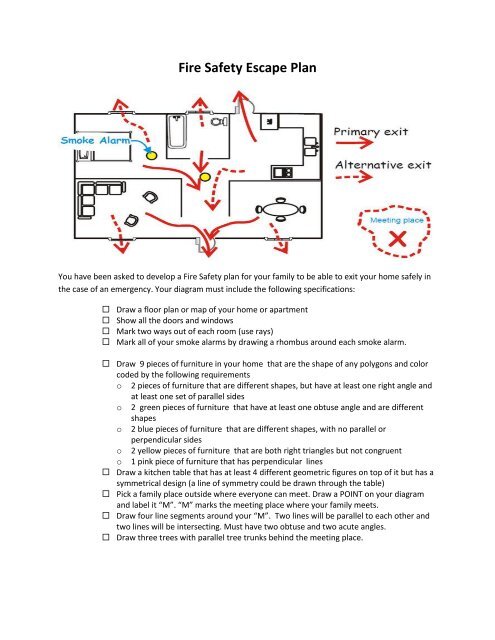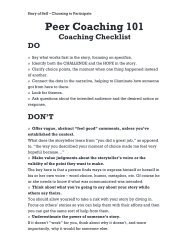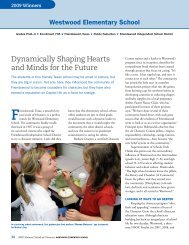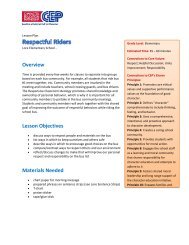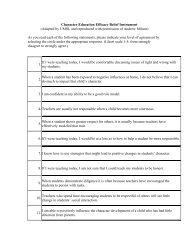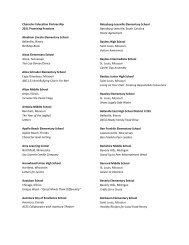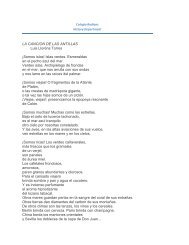Fire Safety Handouts.pdf - Character Education Partnership
Fire Safety Handouts.pdf - Character Education Partnership
Fire Safety Handouts.pdf - Character Education Partnership
You also want an ePaper? Increase the reach of your titles
YUMPU automatically turns print PDFs into web optimized ePapers that Google loves.
<strong>Fire</strong> <strong>Safety</strong> Escape Plan<br />
You have been asked to develop a <strong>Fire</strong> <strong>Safety</strong> plan for your family to be able to exit your home safely in<br />
the case of an emergency. Your diagram must include the following specifications:<br />
Draw a floor plan or map of your home or apartment<br />
Show all the doors and windows<br />
Mark two ways out of each room (use rays)<br />
Mark all of your smoke alarms by drawing a rhombus around each smoke alarm.<br />
Draw 9 pieces of furniture in your home that are the shape of any polygons and color<br />
coded by the following requirements<br />
o 2 pieces of furniture that are different shapes, but have at least one right angle and<br />
at least one set of parallel sides<br />
o 2 green pieces of furniture that have at least one obtuse angle and are different<br />
shapes<br />
o 2 blue pieces of furniture that are different shapes, with no parallel or<br />
perpendicular sides<br />
o 2 yellow pieces of furniture that are both right triangles but not congruent<br />
o 1 pink piece of furniture that has perpendicular lines<br />
Draw a kitchen table that has at least 4 different geometric figures on top of it but has a<br />
symmetrical design (a line of symmetry could be drawn through the table)<br />
Pick a family place outside where everyone can meet. Draw a POINT on your diagram<br />
and label it “M”. “M” marks the meeting place where your family meets.<br />
Draw four line segments around your “M”. Two lines will be parallel to each other and<br />
two lines will be intersecting. Must have two obtuse and two acute angles.<br />
Draw three trees with parallel tree trunks behind the meeting place.
How to Make a Home <strong>Fire</strong> Escape Plan<br />
m _Draw a map of your home. Show all doors and windows.<br />
m Visit each room. Find two ways out.<br />
m All windows and doors should open easily. You should be able to use them<br />
to get outside.<br />
m Make sure your home has smoke alarms. Push the test button to make sure<br />
each alarm is working.<br />
m Pick a meeting place outside. It should be in front of your home.<br />
Everyone will meet at the meeting place.<br />
m Make sure your house or building number can be seen from the street.<br />
m Talk about your plan with everyone in your home.<br />
m _Learn the emergency phone number for your fire department.<br />
Practice your home fire escape drill!<br />
m<br />
WINDOW<br />
WINDOW WINDOW<br />
WINDOW<br />
WINDOW<br />
DOOR<br />
WINDOW WINDOW<br />
© 2010 NFPA The name and image of Sparky ® are trademarks of the NFPA.<br />
WINDOW<br />
WINDOW<br />
WINDOW<br />
DOOR<br />
Meeting<br />
Place<br />
m<br />
Make your own home fire escape plan on the back of this paper.<br />
— Keeping Your Community Safe with Home <strong>Fire</strong> Escape Drills —<br />
NFPA • 1 Batterymarch Park, Quincy, MA 02169 • www.nfpa.org/education
Home <strong>Fire</strong> Escape Plan<br />
Memorize your fire department’s<br />
emergency phone number and write it here:<br />
Use the space below to create your home fire escape plan.<br />
• Draw a floor plan or a map of your home. Show all doors and windows.<br />
• Mark two ways out of each room.<br />
• Mark all of the smoke alarms with . Smoke alarms should be in each<br />
sleeping room, outside each sleeping area, and on every level of the home.<br />
• Pick a family meeting place outside where everyone can meet.<br />
• Remember, practice your plan at least twice a year!<br />
Check out www.sparky.org for fire safety games and activities.<br />
Sparky® is a trademark of NFPA.<br />
Grown-ups: Children don’t always awake when the smoke alarm sounds. Know what your child will do before a fire occurs.<br />
Get more information on smoke alarms and escape planning at www.nfpa.org/factsheets.
Home <strong>Fire</strong> <strong>Safety</strong> Survey<br />
General<br />
r Yes r No<br />
r Yes r No<br />
r Yes r No<br />
r Yes r No<br />
Home has smoke alarms on every level.<br />
Home has a smoke alarm in every bedroom.<br />
Smoke alarms are located outside each separate sleeping area.<br />
Smoke alarms are located at least 10 feet from a stationary or<br />
fixed cooking appliance.<br />
r Yes r No For larger homes (where the interior floor area on a given level is greater than 1,000<br />
square feet), there is an average of at least 1 smoke alarm for every 500 square feet.<br />
[See NFPA 72-2007 11.5.1.3, 29.5.1.3 (2010)]<br />
r Yes r No<br />
r Yes r No<br />
r Yes r No<br />
r Yes r No<br />
r Yes r No<br />
r Yes r No<br />
r Yes r No<br />
r Yes r No<br />
r Yes r No<br />
r Yes r No<br />
r Yes r No<br />
r Yes r No<br />
r Yes r No<br />
r Yes r No<br />
r Yes r No<br />
Smoke alarms are interconnected so when one sounds, they all sound. (Best protection)<br />
Home has ionization smoke alarms.<br />
Home has photoelectric smoke alarms.<br />
Home has combination (photoelectric and ionization) smoke alarms.<br />
All smoke alarms are working.<br />
Family has a home fire escape plan.<br />
Family practices the home fire escape plan at least twice a year.<br />
The home has occupant(s) that require assistance to escape. Occupants discuss escape<br />
planning and occupant requirements in case of a fire or emergency escape.<br />
House number is visible from the street.<br />
Windows used for escape open easily — not blocked by furniture, security bars or<br />
nailed/painted shut.<br />
Security bars, if present, have a quick release-device.<br />
Home has a home fire sprinkler system. (Best protection)<br />
Home has a carbon monoxide alarm outside each separate sleeping area.<br />
Home has a carbon monoxide alarm on every level.<br />
Carbon monoxide alarms are working.<br />
Throughout the Home<br />
r Yes r No Smokers smoke outside the home.<br />
r Yes r No Large ashtrays are provided outside for smokers.<br />
r Yes r No Matches and lighters are stored in a secure cabinet.<br />
r Yes r No Lit candles are not left unattended.<br />
r Yes r No Flammable liquids, if stored in the home, are limited in quantify.<br />
r Yes r No The home is not cluttered with clothes, magazines, newspapers and other items that can burn.<br />
Kitchen<br />
r Yes r No<br />
r Yes r No<br />
r Yes r No<br />
Things that can burn are removed from the stovetop.<br />
Small appliances are unplugged when not in use.<br />
Adult stays in the kitchen when stovetop is in use.<br />
Living/Family Room<br />
r Yes r No <strong>Fire</strong>place has proper screen and hearth.<br />
r Yes r No Things that can burn are at least 3 feet from space heaters and fireplaces.<br />
Bedrooms<br />
r Yes r No<br />
All bedrooms have two ways out — window and a door.<br />
Continued on next page —><br />
NFPA • 1 Batterymarch Park, Quincy, MA 02169 • www.nfpa.org/education
Home <strong>Fire</strong> <strong>Safety</strong> Survey<br />
Basement<br />
r Yes r No<br />
r Yes r No<br />
r Yes r No<br />
r Yes r No<br />
r Yes r No<br />
r Yes r No<br />
Garage<br />
r Yes r No<br />
r Yes r No<br />
r Yes r No<br />
Workshop area is clean of things that can burn.<br />
Hot water heater is set at no higher than 120° Fahrenheit.<br />
Things that can burn are at least 3 feet from the furnace.<br />
Furnace is inspected and cleaned annually.<br />
Chimney is inspected annually and cleaned as needed.<br />
Clothes dryer lint filter and vent pipe are clean.<br />
There is a solid door between garage and residence.<br />
Gas powered equipment is stored in an outside shed or garage, separate from the home.<br />
Gasoline is stored in an approved safety container in an outside shed or garage, separate<br />
from the home.<br />
Outside the Home<br />
r Yes r No Outside electrical receptacles are GFCI and they are in good working condition.<br />
r Yes r No There is no rubbish, trash, brush or tree trimmings accumulation on the property.<br />
r Yes r No Barbecue grill is only used outdoors.<br />
r Yes r No Swimming pool or hot tub is enclosed by a four-sided fence and locked gate. Filter, heater or<br />
hot tub is properly grounded.<br />
Electrical<br />
r Yes r No AFCIs (arc-fault circuit interrupters) are installed throughout the home and they are<br />
working properly (new home construction only).<br />
r Yes r No Kitchen and bathrooms have GFCI outlets on countertop surfaces within 6 feet of running<br />
water outlets and they are working properly.<br />
r Yes r No All receptacle and switch faceplates are installed and in good condition.<br />
r Yes r No Receptacles have been tested and are in good working condition — no evidence of arcing or<br />
overheating.<br />
r Yes r No Switches are in good condition — no evidence of arcing or overheating.<br />
r Yes r No Lighting fixture canopies are fastened in place and fixture is in good condition.<br />
r Yes r No Bulbs in light fixtures are the correct wattage for the lighting fixture.<br />
r Yes r No Flexible cords and cables are not used as fixed wiring, run through holes in walls, ceiling or<br />
floor, run through doorways or windows or under carpets or attached to building surfaces.<br />
r Yes r No If there are young children in the home, the home has tamper-resistant outlets.<br />
r Yes r No Panel board and distribution equipment is accessible for inspection and in good condition —<br />
no evidence of overheating, corrosion or other damage.<br />
r Yes r No Service entrance raceways or cables are fastened in place, grounded, readily accessible and in<br />
good condition.<br />
Stair <strong>Safety</strong> Trips and falls on stairs are a leading cause of home injuries.<br />
r Yes r No Stair is provided with a handrail(s).<br />
r Yes r No Stair can be illuminated for night time use.<br />
r Yes r No Stair tread depth and riser height are uniform.<br />
r Yes r No Stair landing nosing projections are consistent with other nosings on the stair flight.<br />
(You can determine this by doing a “crouch and sight” test. Crouch down at the top landing<br />
of the stair. All the nosings from the landing to the bottom step should line up.)<br />
With your consent, the Home <strong>Fire</strong> <strong>Safety</strong> Survey Team has done a fire inspection of your home. The items checked “No”<br />
may put you and your family at risk. You are urged to correct these at once for your own safety. This inspection does not<br />
identify future conditions such as failure of components, wiring or human behavior which could result in a fire.<br />
NFPA • 1 Batterymarch Park, Quincy, MA 02169 • www.nfpa.org/education


